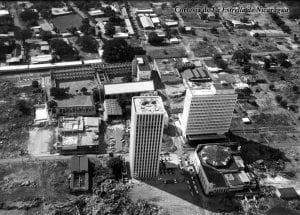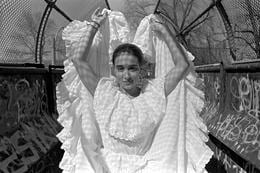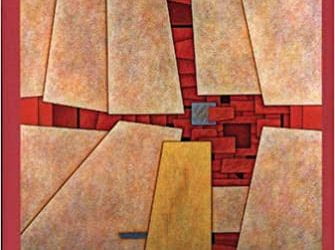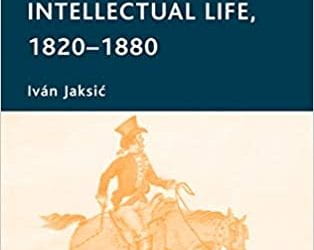Lessons in Güegüense
An Old Dancer

“Managua, Terremoto 1972-Distrito Bancario” by marcel.toruno is licensed under CC BY 2.0
I remember the setting well because the name captivated me: Ruinas del Gran Hotel. It was exactly that: the remains of a luxurious building that, from the 1940s until the earthquake that destroyed Managua the day before Christmas Eve of 1972, had lodged distinguished guests and stars of the international jet set. It was located on Avenida Roosevelt, in what had begun to be remembered in my childhood as “Old Managua”, a had-been downtown full of ruins and besieged by the ghost of continuing war that did not allow the luxury of reconstruction. It was the Nicaragua of the eighties, the country of Sandinistas and Contras that vanished from international newscasts soon after the fall of the Berlin Wall.
Seeing the Güegüense for the first time was part of a delicious pact with my mother, who rewarded my studiousness by taking me to shows. The interior of the Ruinas seemed oblivious to the sordidness around it. It was all light and movement: hats with golden tops adorned with tall feathers and loud colors, red, purple, green; sequins reflecting fluorescent lights, multiplying the colors of wide skirts and undulating handkerchiefs; damsels with Spanish fans and flirtatious curls; violins, guitars, drums, laughter, and masks. Masks, above all: some with chalk-white faces, huge blue irises and blonde mustaches; some with brown faces and black mustaches; and the most intriguing of all, the long black faces of the mules which, endowed with men’s bodies, were shaking a rattle with one hand and dancing in a row, sometimes galloping and sometimes stumbling like drunkards.
La comedia del Güegüense o Macho Ratón is a work of unknown author that, according to researcher Carlos Mántica, possibly dates back to 1675. Daniel Garrinton Brinton translated it to English and published it for the first time in 1883. It is a combination of dances, music, and comedic dialogue written in a mix of Spanish and Nahuat, a local variant of the lingua franca of the Mesoamerican peoples that had been conquered by the Aztecs. It deals with a traveling merchant, an Indian or mestizo (a person of European and American Indian race), called Güegüense. As he travels through Nicaragua, a Spanish-born governor tries to bribe him. But Güegüense, feigning politeness and postponing the payment with dances and misunderstandings, gets the governor to pay him instead. The governor offers his daughter’s hand in exchange for a cut of the supposed (and nonexistent) riches of the merchant.
The dances of the Güegüense are a living tradition in Nicaragua. Each January, during the festival honoring Saint Sebastian, patron of the town of Diriamba, the Güegüense takes to the streets. Performances by the National Folkloric Ballet and other dance groups, sometimes accompanied by the National Orchestra in civil functions and gala events in Managua and abroad, attest to its adaptation as a symbol of national identity.
The work’s literary merit has been debated. In the nineteenth century, Nicaraguan poet Rubén Darío wrote that it was of a work of “primitive simplicity”, with a monotonous dialogue and scant plot. José Martí, another great figure of Latin American modernism, called its language a “crude dialect,” but nonetheless saw the work as a “masterful comedy.” Philologist and literary critic Pedro Henríquez Ureña warned in 1938 that there was “little to be gained” from its study.
Other critics have showered it with superlatives: “the masterpiece of American Indian picaresque” (Carlos Mántica); “a masterful piece of street theater” (Milagros Palma); “the first expression of protest” in South America (Reyna Sirias-Ortiz); or “the key piece of national identity” (Jorge Eduardo Arellano).
In 2005, the United Nations Education, Science and Culture Organization (UNESCO) proclaimed the Güegüense Masterpiece of the Oral and Intangible Heritage of Humanity. This designation recognizes its uniqueness and carries along concrete measures to safeguard it.
The Güegüense plays out the clash between Spanish authorities and the native peoples of the Americas. Many consider it an allegory of indigenous resistance to colonial exploitation or of the onset of the mixture of races known as mestizaje. Political agendas have played a part: it was during the Sandinista era (1979-90) that the interpretation of the work as an expression of a people’s combativeness against foreign exploitation gained popularity; while the persistent and easy interpretation of it as the foundational moment of mestizaje downplays the difficulties of coexistence in a multiethnic nation with serious socioeconomic differences.
The word güegüense comes from the Nahuatl language and has been variously translated as “honorable elder” and “rascal” (Mántica). These meanings reflect the ambivalence of the character, who on the one hand is ingenious and skillful, with an old man’s know-how, and on the other is vulgar, deceiving and given to usury—as his own sons remind him several times in the dialogue, to the audience’s amusement.
The Güegüense reflects the colonial image of the mestizo as a dishonest and vile person. It is this image that Inca Garcilaso de la Vega, son of an Inca princess and a Spanish captain, seeks to vindicate himself from when he writes the first part of his Comentarios reales (1609), a history of the Incas written in elegant Spanish prose. According to Harvard Professor Doris Sommer, one of Garcilaso’s strategies for authorizing himself is to flaunt his native knowledge of Quechua, hinting at the ridicule the Spanish conquerors were exposed to because of their verbal ineptitude before the Incas. Another strategy is to postpone his chronicle with disconcerting preambles.
The Güegüense is also the story of a mestizo who undermines colonial authority using his mastery of two languages and delay. But his ploys are different: he uses misunderstandings that carry insults, hyperboles that erect riches where none exist, and, above all, dancing. Each time the governor tries to talk about his payment, Güegüense proposes a new dance. Fourteen dances later, it all ends in a wedding to Güegüense’s benefit. If Garcilaso’s elegant prose somehow protected him from being accused of duplicity, Güegüense engages in duplicity without qualm, joyfully embodying the stereotype and exceeding the word as his locus of action. If Garcilaso metaphorically moves through different places of enunciation in his text, disconcerting and yet attracting the reader (Sommer), when Güegüense dances he executes a literal movement through the performance space—which can be a theater as well as a street—inviting the spectator to also participate bodily, with her laughter and her senses fixed in the spectacle.
More than allegorizing a conflict, the Güegüense represents a successful negotiation. The protagonist is not a simple model to follow. He is rather an anti-hero who can arouse both sympathy and rejection in the spectator. For a country eager to overcome a history of armed conflicts and institutional corruption, it is a good way to start a self-critical dialogue about the different options at hand when resolving conflicts and surmounting obstacles.
But beyond its possible historical, literary or didactic value, for me the Güegüense has a living value that I associate with my childish awe that night at the Ruinas del Gran Hotel—knowing how to turn seemingly insurmountable situations into reasons for laughter and joy in art, despite all expectations.
Lecciones del Güegüense
Un Viejo Bailador
Por Alba F. Aragón
Recuerdo bien el escenario porque me cautivó su nombre: Ruinas del Gran Hotel. Era, literalmente, eso: los restos de un lujoso edificio que desde los años cuarenta hasta el terremoto que destruyó Managua la víspera de Nochebuena de 1972, había acogido a distinguidos huéspedes y estrellas de la farándula internacional. Estaba en la Avenida Roosevelt, en lo que en mi niñez se empezó a recordar como “la vieja Managua”, antiguo centro urbano poblado de escombros y asediado por el espectro de la guerra continua, que no permitía el lujo de la reconstrucción. Era la Nicaragua de los ochenta, la de sandinistas y contras, que desapareció de los noticieros internacionales poco después que cayera el muro de Berlín.
Ver el baile del Güegüense por primera vez fue parte de una deliciosa complicidad con mi madre, que premiaba mi diligencia en los estudios llevándome a espectáculos. El interior de las Ruinas parecía ignorar la sordidez que lo rodeaba: era todo luminosidad y movimiento; sombreros de copas doradas con plumas altas y colores chillones, verde, rojo, púrpura; lentejuelas refractando la luz de bombillas fluorescentes y multiplicando los colores de las faldas amplias; pañuelos ondulantes, señoritas de rulos y abanicos coquetos; violines, guitarras, tambores, risas y máscaras. Máscaras, sobre todo: caras blanco-tiza con enormes irises azules y bigotes rubios; caras morenas con bigotes negros; y las más intrigantes, las caras negras y alargadas de los machos o mulos, que, con cuerpo de hombre, agitaban con la mano un cascabel y danzaban en hilera, a veces galopando y a veces dando traspiés de borracho.
La comedia del Güegüense o Macho Ratón es una obra de autor desconocido que, según el estudioso Carlos Mántica, data posiblemente de 1675. Daniel Garrinton Brinton la tradujo al inglés y la editó por primera vez en 1883. La obra es una combinación de bailes, música y parlamentos escritos en una mezcla de castellano y náhuat, variación local de la lingua franca de los pueblos mesoamericanos dominados por los aztecas. Trata del paso de un mercader ambulante, un indio o mestizo llamado Güegüense, por una provincia de Nicaragua. El gobernador de origen español pretende sobornarlo para permitir su paso. Pero el Güegüense, fingiendo cordialidad y postergando el trámite con bailes, consigue que el gobernador le pague a él, cediendo a su hija en matrimonio a cambio de una “mordida” de las supuestas (e inexistentes) riquezas del mercader.
Los bailes del Güegüense son una tradición viva en Nicaragua. Cada mes de enero, durante el festival patronal de San Sebastián en el pueblo de Diriamba, el Güegüense sale a la calle. Sus interpretaciones por el Ballet Folclórico Nacional y otros grupos de danza, en ocasiones acompañados por la Orquesta Nacional en funciones cívicas y eventos de gala en Managua y en el extranjero demuestran, además, su adaptación como estandarte de identidad nacional. Su valor literario ha sido debatido. En el siglo XIX, el poeta nicaragüense Rubén Darío opinó que era “de una simplicidad primitiva”, de diálogos monótonos y escaso argumento. José Martí, otra gran figura del modernismo latinoamericano, calificó su lenguaje de “dialecto burdo” y sin embargo vio en la obra una “comedia maestra”. Por su parte, el filólogo y crítico literario Pedro Henríquez Ureña advirtió en 1938 que “es poco lo que se obtiene” de la obra.
Otros críticos han calificado el Güegüense con superlativos: “obra maestra de la picaresca indoamericana” (Carlos Mántica), “la pieza magistral del teatro callejero” (Milagros Palma), “la primera expresión de protesta” en América (Reyna Sirias-Ortiz), o la “obra clave de la identidad nacional”(Jorge Eduardo Arellano).
En el año 2005, la Organización de las Naciones Unidas para la Educación, la Ciencia y la Cultura (UNESCO) proclamó el Güegüense Obra Maestra del Patrimonio Oral e Inmaterial de la Humanidad. Esta designación reconoce su singularidad y conlleva medidas concretas para salvaguardarla.
El Güegüense escenifica el choque entre las autoridades españolas y los pueblos nativos de América, alegorizando para muchos la resistencia indígena a la explotación colonial o la incipiente confluencia de razas en el mestizaje. Así, el Güegüense ha tenido como trasfondo agendas políticas: fue durante la era sandinista (1979-90) que se popularizó su interpretación como expresión de un pueblo combativo ante la explotación extranjera; mientras que su interpretación perenne y fácil como el momento fundacional del mestizaje soslaya las dificultades de la convivencia en un país multiétnico con graves diferencias socioeconómicas.
La palabra “güegüense” proviene del náhuatl y se ha traducido variamente como “respetable anciano” y como “sinvergüenza” (Mántica). Estos significados reflejan la ambivalencia del personaje, que por una parte es ingenioso y hábil, y por otra es vulgar, mentiroso y usurero—como sus mismos hijos le recuerdan en el diálogo, para risa del público.
El Güegüense refleja la imagen que se tenía en tiempos coloniales de los mestizos como seres viles y deshonestos. De esta imagen busca reivindicarse el Inca Garcilaso de la Vega, hijo de una princesa Inca y un capitán español, con la primera parte de sus Comentarios reales (1609), su historia de los Incas escrita en elegante prosa castellana. Según la profesora de Harvard Doris Sommer, una de las estrategias del Inca Garcilaso para autorizarse es ostentar su conocimiento nativo del quechua, sugiriendo el ridículo al que se exponían los conquistadores por su ineptitud verbal ante los incas; otra es postergar su relato con preámbulos desconcertantes.
El Güegüense también es la trama de un mestizo que socava la autoridad colonial con su dominio de dos lenguas y la postergación, pero sus artificios son otros: equívocos que conllevan insultos, hipérboles que erigen riquezas donde ninguna existe, y ante todo, el baile. Cada vez que el gobernador insiste en hablar de la paga de impuestos, el Güegüense propone otro baile. Catorce bailes más tarde, todo acaba en una boda que favorece al Güegüense. Si la prosa elegante de Garcilaso lo protegía de algún modo de posibles acusaciones de duplicidad, el Güegüense se dedica a ella sin reparo, encarnando gozosamente el estereotipo y excediendo la palabra como locus de acción. Si Garcilaso se desplaza metafóricamente por distintos lugares de enunciación en su texto, desconcertando y atrayendo al lector (Sommer), al bailar el Güegüense ejecuta un desplazamiento literal por el espacio escénico—que bien puede ser teatro o calle—invitando al espectador a participar corporalmente, con su risa y sus sentidos fijos en el espectáculo.
Más allá de alegorizar un conflicto, el Güegüense representa una negociación fructuosa. Su protagonista no es un fácil modelo a seguir. Es más bien un anti-héroe que puede inspirar tanto simpatía como rechazo en el espectador. Para un pueblo ansioso por superar una historia de conflictos armados y corrupción institucional, es un buen motivo para dialogar de modo auto-crítico sobre los distintos comportamientos disponibles a la hora de resolver conflictos y salir de los atascos. Pero más allá de su posible valor histórico, literario o didáctico, el Güegüense guarda para mí un valor vital que relaciono con el asombro infantil de esa noche en las Ruinas del Gran Hotel—el saber hacer de situaciones aparentemente insuperables motivos de risa y goce en el arte, por encima de todos los pronósticos.
Alba F. Aragón is a PhD student at Harvard University’s Department of Romance Languages and Literatures. She is currently putting together a team to film a documentary about the Güegüense. If you are interested, she can be reached at aragon@ fas.harvard.edu.
Related Articles
Disruption in the Immigrant Experience: Colombian Youth Dance Their Way to Continuity
Imagine you are fifteen years old. As an immigrant who has lived in the United States for a few years, you are still trying to find your place. You decide to join a group that dances the traditional dances of your country. You practice every week on Fridays, when you could be going to the movies or hanging out with your friends. Your goal is to perform in that big annual show a lot of people have told you about. That day has finally …
Review of Connecting Lines: New Poetry from Mexico
Lou Dobbs and other talk show hosts want us to believe that a so-called Mexican invasion is denying “true” Americans their jobs, democracy and destiny. Few among them comment on a peaceful, more subtle Mexican “invasion” that will help us see why fears of blending Mexican and U.S. culture are misplaced. One by one, since the turn of the century, anthologies of a Mexican poetry trumpeting innovation and diversity have been …
Review of The Hispanic World and American Intellectual Life, 1820-1880
Iván Jaksić’s highly original and engaging scholarship on the origins of U.S. academic interest in Ibero-America brilliantly reveals previously unknown trans-Atlantic and Western hemisphere intellectual networks. His research focuses on the life, interactions and contributions of those Jaksić calls“the pioneer American scholars and lifetime students of the Hispanic World”—Washington Irving, George Ticknor, Henry Wadsworth …




